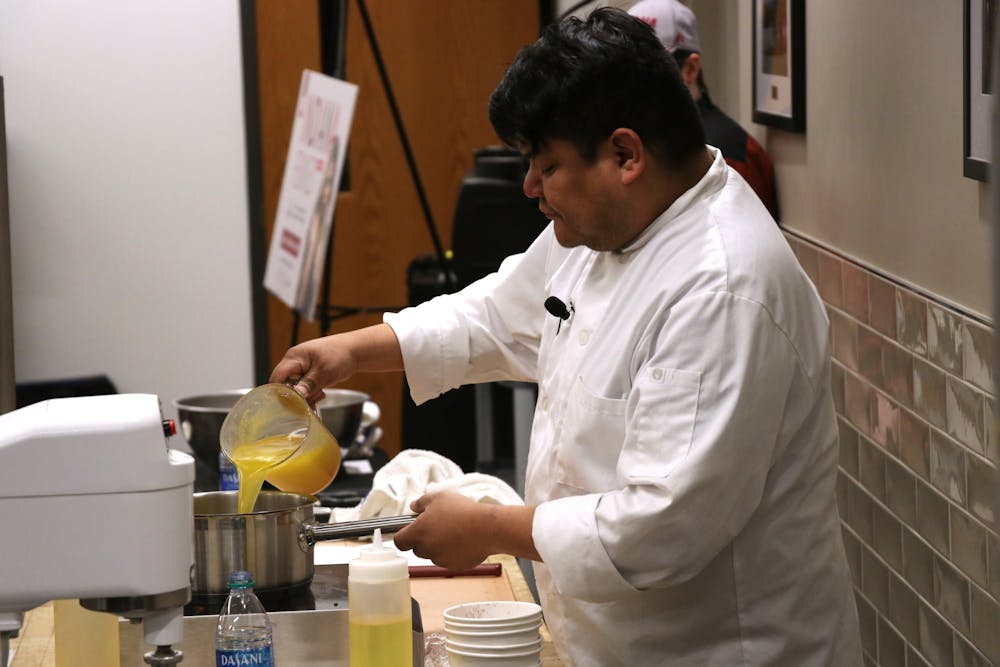The smell of New Mexican chili powder wafted through the air as Native American Chef Freddie Bitsoie placed the seasoned pork in the pan. As he rotated the tenderloin, the smell grew stronger.
Audience members sniffed the air, captivated by the spices. Some breathed in so deeply they coughed.
“Thank you,” Bitsoie said. “Tomorrow your sinuses will be clear.”
Bitsoie, executive chef at the Mitsitam Native Foods Café at the Smithsonian National Museum of the American Indian, prepared four dishes for a cooking demonstration Wednesday afternoon in the Bookmarket Eatery in Wells Library. The menu prepared by Bitsoie was sold at the Traveler food station in that same area.
Throughout his talk, Bitsoie, a member of the Diné (Navajo) Nation, frequently discussed how culture is connected to food.
He discussed how the domestication of animals changed Native people’s diet. He also explained that Native food is more expensive because of availability and the fact that few people work to get Native ingredients such as Heart of Palm.
This demonstration was a part of 2020 Indiana Remixed Festival. Joe Hiland, associate director of the IU Arts and Humanities Council, said the council worked with IU Dining, IU Food Institute and the First Nations Educational and Cultural Center to bring Bitsoie to IU.
Hiland said while the festival mainly includes what would be considered traditional art forms, such as dance, painting and music, it was important to include culinary arts because food is a defining trait of most world cultures.
One of the plates Bitsoie prepared was a combination of two recipes: a spice-rubbed pork tenderloin and a three-bean ragout.
For the pork tenderloin, Bitsoie seasoned the meat with cayenne pepper, chili powder, cumin, brown sugar, dry mustard, dried sage and extra kosher salt and turned it a few times in a pan with oil and then put in the oven “till it was done.”
He then placed the pork over theragout, or stew, which included onion, garlic, thyme, bay leaf, carrot, celery, tomatoes, chicken stock and kidney, black and cannellini beans.
The other dishes were a swamp cabbage, also called Hearts of Palm, salad, calabasas and prickly pear cheese mousse.
“This recipe actually got a guy and girl engaged,” Bitsoie said of the mousse. “Seriously.”
While Bitsoie prepared the food, he taught the audience about food culture and talked through various cooking tips, some specifically relating to Native food ways.
Salt is a tool, he said. It dehydrates the vegetables and helps them sweat, or release steam.
Chilies should be sweet, not too spicy.
Use water while you cook to help deglaze the bottom of the pan.
“Does anybody know why we add tomatoes?” Bitsoie asked his audience.
Audience member Harriet Castrataro, a retired IU adviser who attended because she wanted to learn new cooking techniques, said it was because of the acidity.
Another attendee suggested they were for color.
Tomatoes are used because their seeds help to thicken the stew, Bitsoie said.
He said he likes to use ingredients that have traditionally been used to prepare Native foods. He said that the other part of his job, outside of cooking, is learning more about Native foods and teaching people about them.
“I try to define Native cuisine, what it’s about and how it has changed in the past 20 years,” Bitsoie said.
Hiland said it was important for IU to invite someone who works in indigenous culinary traditions.
“We are living, working, creating on lands that originally belonged to indigenous peoples,” he said. “It’s important for us as a university to acknowledge our indebtedness to those traditions and those cultures, and I think a cooking demo like this is one way to sort of raising consciousness for our community and think a little bit about what we owe to indigenous peoples.”
Nicky Belle, First Nations Educational and Cultural Center director, said he enjoyed the presentation because it focused on the contemporary aspects of Native culture.
“Bringing in Freddie is a perfect example of the way we are able to help educate through a modern lens,” Belle said. “Freddie presented perfect examples of how contemporary Native cuisine is that. It is cuisine.”





